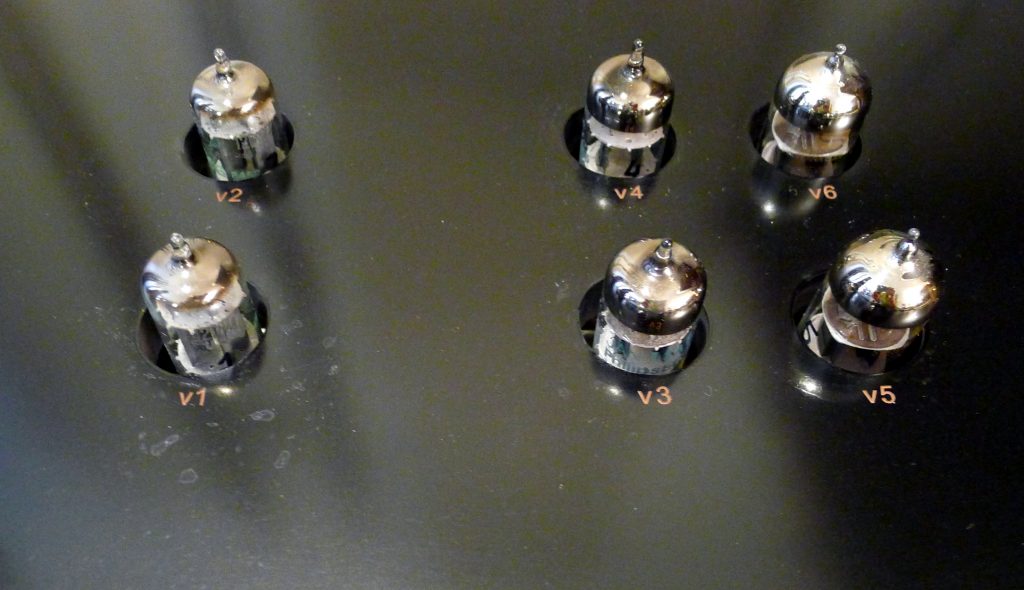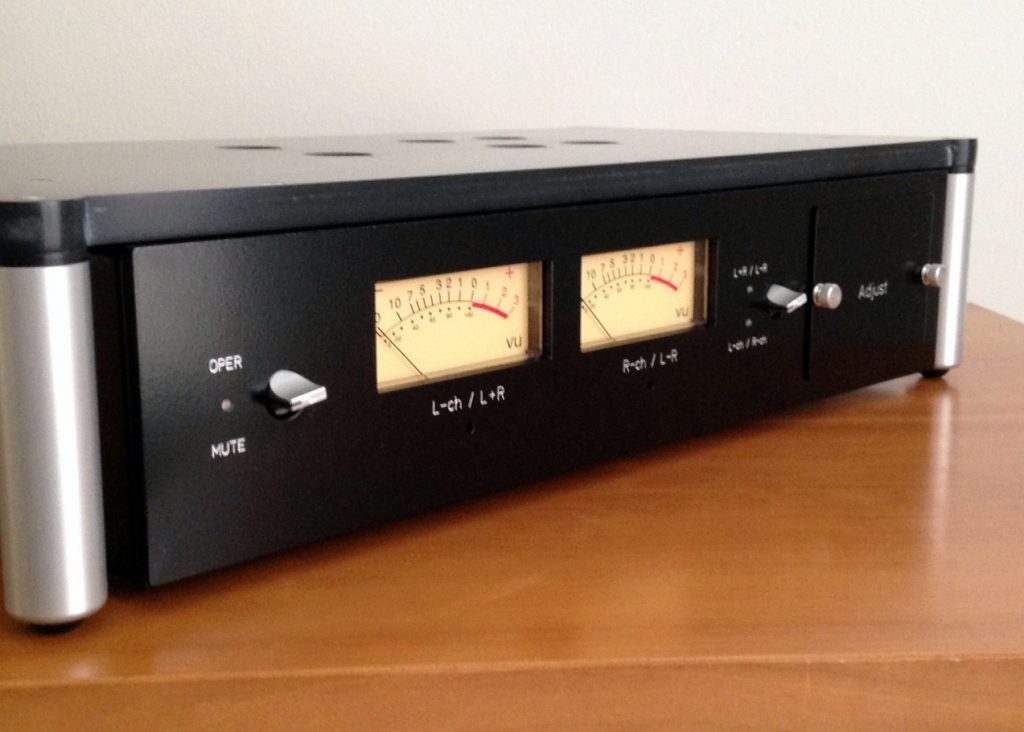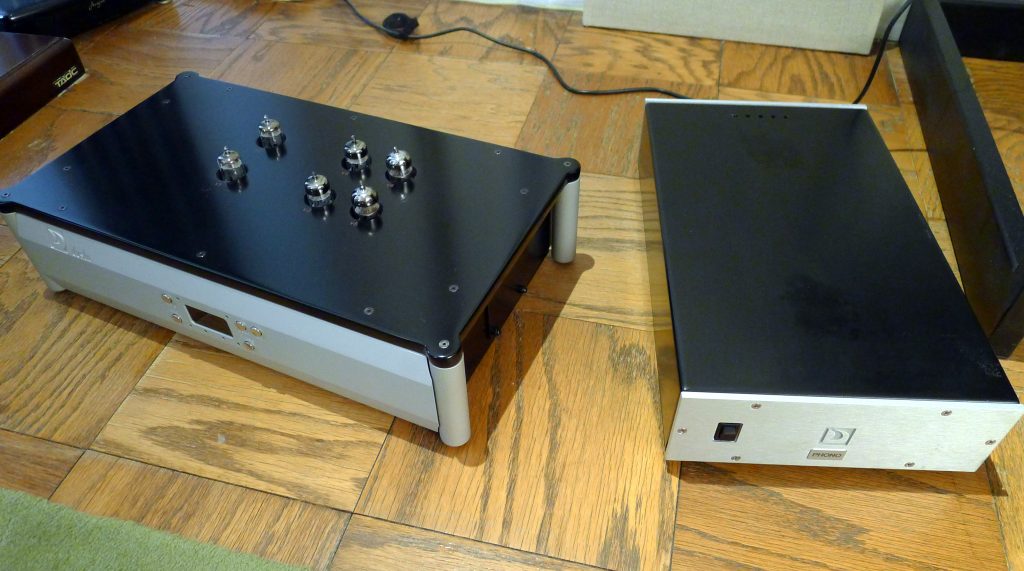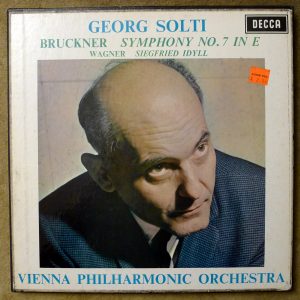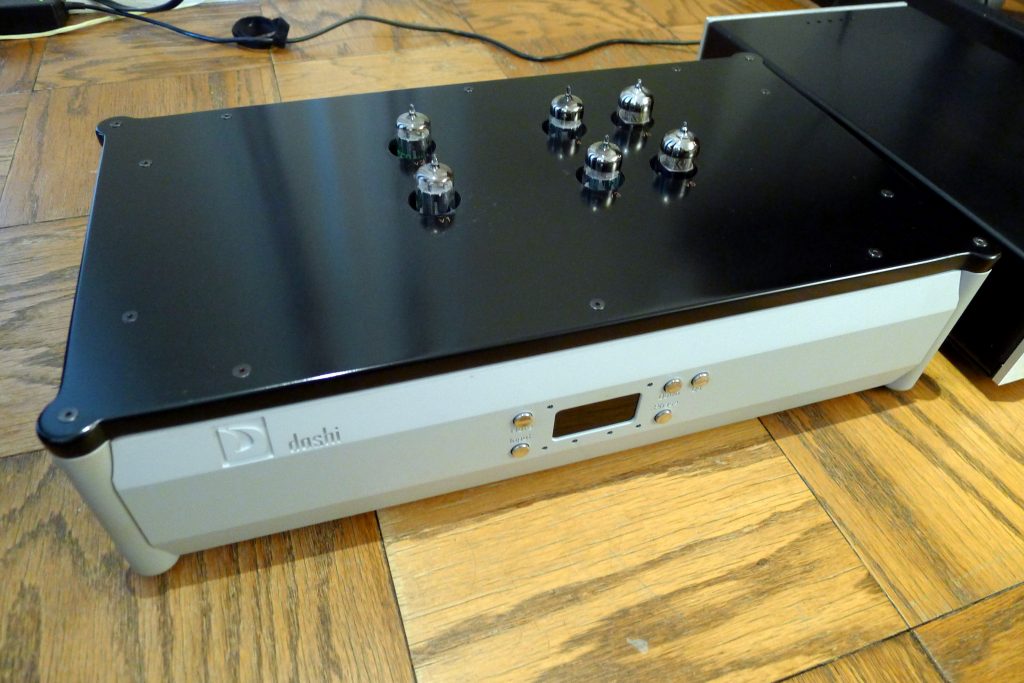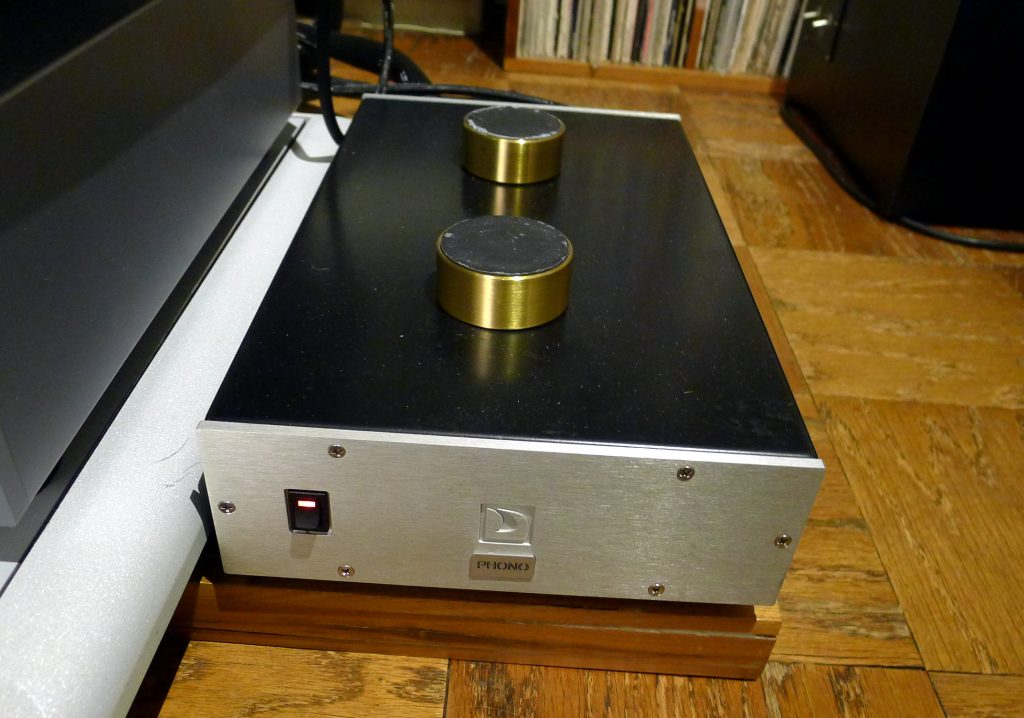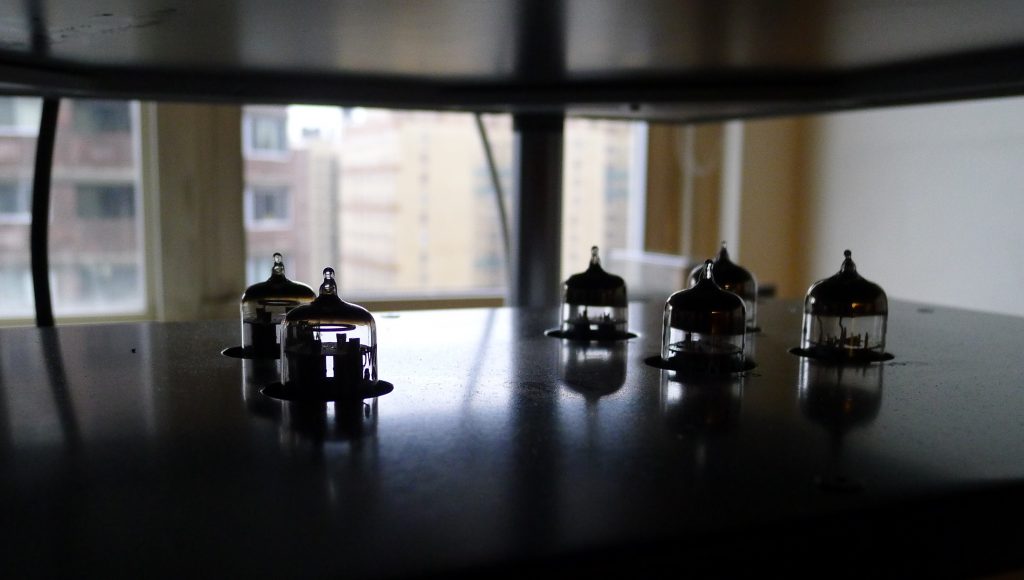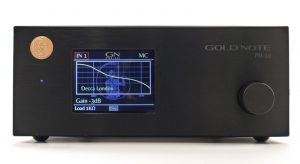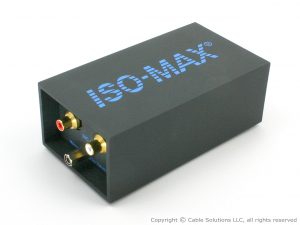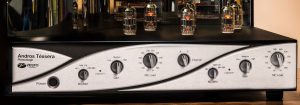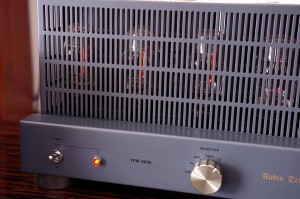'Twas the week before Christmas when Nick Doshi and Anthony Chiarella dropped by bringing seasonal cheer in the form of the Doshi Phono Stage V3.0. While it was warming up, I took the opportunity to bring them up to speed on my current configuration: all CH Precision components, including the CH P1 phono stage.
Nick inquired, "Did I have an opportunity to try the CH dual mono phono stage?"
MN: "Not yet…maybe one day. That's supposed to be killer, but to do that right means four boxes on the floor, including the outboard power supplies. Frankly, where would I put everything? Perhaps you should make one?"
Doshi Studio Phono
Nick: "I do. It's in our Studio series, which actually came first, before the consumer model. It reflects my roots in pro audio; you know I started in radio and TV broadcast transmission, right? It features VU meters, calibration controls for archival use, adjustable equalization, level settings—all the tools a pro needs. And it's only two chassis with a list of $17,900."
However, that's not what they delivered today. I received the Phono Stage V3.0 for the consumer market, with the same number of boxes and list price. Nick jumped right into "…a couple of things you should know. Number one: we use a step-down transformer. This is big, maybe an industry first; I don't know of anyone else doing that."
The Step-down Transformer
He began laying out the technical benefits of a step-down transformer from an engineer's point of view, but soon halted when he noticed my glazed-over expression and wisely referred me to his website, where I later pulled up the following:
…the Doshi Phono Preamplifier includes a Moving Coil Pre-Preamplifier whose J-Fet transistors provide 26 dB of gain, followed by a pair of monaural, 2:1 step-down transformers which lower gain to 20 dB. Although MC head amps often use step-up transformers to increase gain our novel use of step-down transformers accomplishes three critical benefits:
- Provides Galvanic Isolation, keeping Pre-Preamplifier grounds separate from the rest of the preamp
- Converts balanced cartridge input to single ended output, enabling our "Zero-Feedback" tube circuit
- Impedance is stepped-down 4:1, providing increased bandwidth and a low impedance output to drive the tube MM section.
That first bullet about Galvanic Isolation sounded familiar. I went back to my Doshi Preamp V3.0 review from last year and, sure enough, it was a key feature, although in the Preamp it is accomplished by using a Transformer Volume Control. In fact the whole list of Preamp design bullets carries over to the Phono. No need to rewrite it, I'll just crib from that review.
- Three Stage Decoupling ™
Behind its sculpted aluminum faceplate, the chassis of our preamplifier incorporates Doshi's Three Stage Decoupling™ technology to virtually eliminate the influence of both external and internal resonances. Inside the chassis, critical audio circuits are point-to-point wired and mounted on an acoustically isolated sub-chassis. The entire sub-chassis is suspended from a ½" thick slab of laser-cut, DuPont Corian. The heavy Corian slab is the top plate of the chassis. It is, in turn, mechanically decoupled from the sides of the chassis by vibration absorbing spacers in each corner.
Both main and power supply chassis are constructed from extremely strong, powder-coated, 14-gauge, non-magnetic stainless steel, an extra expense undertaken to achieve freedom from resonance and unmatched strength.
- Ultra-Stable Power Supply
An over-sized toroidal transformer (designed by Doshi and manufactured by Toroid), plus massive amounts of capacitance and three levels of current filtration provide enormous reserves of high-purity power. The transformer is massively over-specified to prevent the kind of resonances that occur when a transformer is run at full capacity.
Special care went into selecting the umbilical cable connecting the main chassis and PSU. We have found it has an outsized impact on sound quality. Many prototypes were tested before we settled on a 9 conductor, heavily damped and shielded wire made to our specifications by New England Wire, a supplier to some of highest-end audiophile cable companies.
- Over-Specified Parts
All internal components are oversized, so that no part is ever driven at or near its limit. Over-specifying parts prevents stress, distortion, dynamic compression and maximizes reliability.
La Musica
Let's turn now to la musica.
A busy score like the Bruckner Symphony No. 7, with Solti and the Vienna Philharmonic (Decca SET 323-4), fills the stage with massive forces, maybe 100 musicians. To have any chance of understanding how all the parts fit together demands you give it full attention, and this can be mentally fatiguing. Quite often, when side A is done, I'm apt to call it a day. Curiously, with the Phono V3.0 in line, after side A, I want to flip the record. How does this happen?
What a well-organized soundstage! Not in the sense of tidy and sanitized—no, the Phono V3.0 has too much warmth, body and tonal density to be associated with anything of that description. Well-organized in that there are no malformed or amusical sounds on it. Everything you hear conceivably originates from the master tape and seems appropriate. The Phono V3.0 stage is divvied up into large, discrete blocks for each of the sections of the orchestra. Big puffs of air around them and create buffers between the instrument sections. The blocks, in turn, are populated with large, individual images. These are not flimsy or delicate objects; they have abundant flesh and weight.
"Seeing" the music is made easier when it's in this form. (What an oxymoron, but good playback can be intensely visual.) It's as if the Phono V3.0, by organizing it into these blocks, has partially processed the signal and done half the job, so the listener doesn't have to work as hard. Our ear-brains expend less effort parsing it.
How can a component pre-digest the signal and make the listeners job easier? Was I imagining things? I had to call Nick and ran this fantastical observation by him. To my surprise, he understood the phenomenon and had a ready answer:
"On a good recording there are psychoacoustic markers with soundstage information. If these are preserved in playback, the result is what you are describing. To accurately do that, the designer must respect two key elements: dynamic linearity and phase linearity. This is not always the most practical or least expensive solution; often designers opt to cut costs and compromise linearity. For example, this is why we chose the more difficult route of passive RIAA equalization."
The postulate is that a circuit designed with integrity can make the listeners' job easier. I wonder if that explains why some gear is more fun to listen to? This is getting very far out, beyond my comfort zone, and I don't want to speculate further. I can only tell you that listening sessions with the Doshi went on longer and were less taxing.
Dynamics
When one of those legendary Brucknerian crescendos comes rolling along—always a severe test that separates the men from the boys—you will not be left in doubt concerning the Phono V3.0's competency. The quality of the treble and midrange fall in line with what's expected from a good tubed phono stage. The treble is modestly rounded, giving transients a slightly soft edge—that means nothing is hard or edgy.
But the low frequencies kick in generously and ramp up in a powerful wave front to face-off any challenge. Happily, the low-end is not Jell-O-like, but controlled and reasonably firm. Dynamics expand wherever they need to go—it's surprising how much slam the Phono V3.0 can generate—while the soundstage never exhibits strain. To account for this exceptional performance, just look over at that oversized outboard power supply.
Timbre
Generally, tube gear has the advantage in getting violins to sound right, but often they cross the line and overdo it, introducing a degree of euphony. The Doshi definitely has a tubey signature—violins sound warm, silky, just beautiful—but it is not laid on too thick and stays within credible bounds.
General Description
The Doshi Audio Phono V3.0 came along in 2015, replacing the original phono. Here's the overview:
…Doshi's Phono Preamplifier uses three dual triodes per channel to deliver 52 dB of gain (72 dB with head amp), low impedance drive of the passive RIAA EQ circuit, and an output impedance of less than 150 Ohms: an impressive specification more typical of transistor circuits. This topology enables our Phono Preamplifier to drive any load. Compatibility with the widest variety of cables and Line Preamplifiers is assured.
There are three inputs (one MC and two MM). Two sets of RCA outputs are standard, which can be configured as XLR, if needed (additional cost). There are six tubes, two of each type: ECC83/12AX7, ECC81/12AT7, 7247/12DW7.
We installed the Phono V3.0 with current production valves and Nick left me with a set of NOS tubes in case I wanted to indulge in tube rolling. In truth, I never felt temped: the unit sounded so good with the stock ones that I didn't feel the need. I mentioned this to Nick, who was not surprised. He described the painstaking process he went through, testing a wide variety of current production tubes to arrive at the final choices of Russian and Czech manufacture. (Seems there are many countries where valves never went out of production.) In his opinion these are good enough to compete with the best of the NOS, potentially saving you a bundle of $$.
Remote Control of Cartridge Loading
The second item on Nick's "things you should know about the Phono V3.0" was remote control of cartridge loading. The unit comes with a remote for mute, input selection, and "everything loading." (All of these controls are redundant on the front panel.)
The Phono V3.0 can store two MC load settings. The remote allows you to flip between them and adjust their values from the couch, which came in quite handy for initial setup. I began with Load 1 set to 500, Load 2 at 200, and toggled between them. I decremented Load 2 down to 100 to hear to hear what that sounded like, still from the couch. We wound up preferring the loading at 200 ohms.
Installation
The Phono was fed by my Kronos Sparta/Air Tight Opus cartridge/ and the remarkable Argento Flow Master Reference phono cable. As for power cord and interconnect, I replicated what had worked to good effect on the Preamp V3.0: a TARA Labs The Muse power cord and Kubala•Sosna Elation! balanced interconnects. This was not surprising, because the Doshi products have a consistent voicing: your second product acquisition won't sound very different from the first.
A Little Teaser
I happened to have on hand an uber interconnect cable from STEALTH Audio, the Sakra V16 (MSRP: $18,400/m). I had a hunch it would complement the Phono V3.0 very nicely, but the degree of synergy that developed caught me unprepared. It transformed that Bruckner Symphony No. 7 into something else again. I know, I know, this pairing is sort of ridiculous because the cable costs as much as the component. All I can I tell you is it was shockingly good.
The madness escalated when STEALTH sent over their latest, the new Sakra V17 Limited Edition interconnect (MSRP: $27,600/m). Now, that wire on the Phono V3.0… well, you'll have to wait for the review of these wires coming soon.
The HRS Damping Plate
The main chassis of the Phono went on my TAOC rack. The PSU had to go on a constrained layer wood platform on the floor, as I didn't have a free shelf. This left it a little wobbly. At this point Anthony mentioned the benefits of an HRS Damping Plate on top of the PSU. Until I could get one of those in, I used a pair of Walker Audio Valid Point resonance control discs on top. I was surprised at the improvement.
Our gear resides in a shaky, unstable environment; the insidious effects of environmental vibrations are always a factor. With the PSU left untreated, the sound was comparatively soft, unfocused, and a little flat in dimension. The Walker Valid Points applied firming action, improving both tone and image specificity. However, an unwanted byproduct in the form of treble peakiness came with it.
When the HRS DPX-14545 Damping Plate replaced the Walker control discs there was further firming and purging of residual vagueness. The view into the stage clarified, with big gains in presence and dimensionality. Meanwhile, tonal density increased and balance shifted darker—it was weightier without feeling shelved down. The treble smoothed and the peakiness was purged.
The HRS DPX-14545 Damping Plate (MSRP: $340; 14.5" x 4.5" x 1.3"H; 7.1 lbs.) achieved that happy combination I am always looking for: providing insight without introducing analytic qualities. Consider this a mandatory accessory for the PSU.
These experiments with upgraded parts demonstrate that the Phono V3.0 can move into a performance class well beyond its price point with careful selection of ancillary gear.
Conclusion
When the Doshi Phono V3.0 was installed, it was nice to hear a familiar voice. Actually, I was hoping to because I rather enjoyed their Preamp V3.0 (which I reviewed last year and can be found HERE). These components share a definite house sound. It is clear that Nick Doshi knows what he's after and voices his products consistently. (It helps that he has great musical taste.) Your second product acquisition won't sound very different from the first.
The Phono V3.0 shares cosmetics and many engineering elements with the Preamp V3.0, including the same tubey aura. Although the fully-tubed Phono V3.0 has many more valves, it is not overdone. Not a single listener complained about a valve signature.
Perhaps the most idiosyncratic aspect of the Phono V3.0 is one that caught me off guard. The Phono V3.0 laid out a soundstage that was unusually easy for the ear/brain to parse. It was as if the machine had pre-digested the signal, doing some of the work for us. That made listening less tiring, more engaging, and boosted the comfort level of a product that the majority of listeners found to be highly addictive.
At the end of the day, beyond all of the audio aspects, what is most important is what your foot is doing: do you observe it keeping time? Are you grooving to the beat? I most certainly was.
Phono Preamplifier V3.0
Retail: $17,900
Doshi Engineering
Manassas, Virginia




